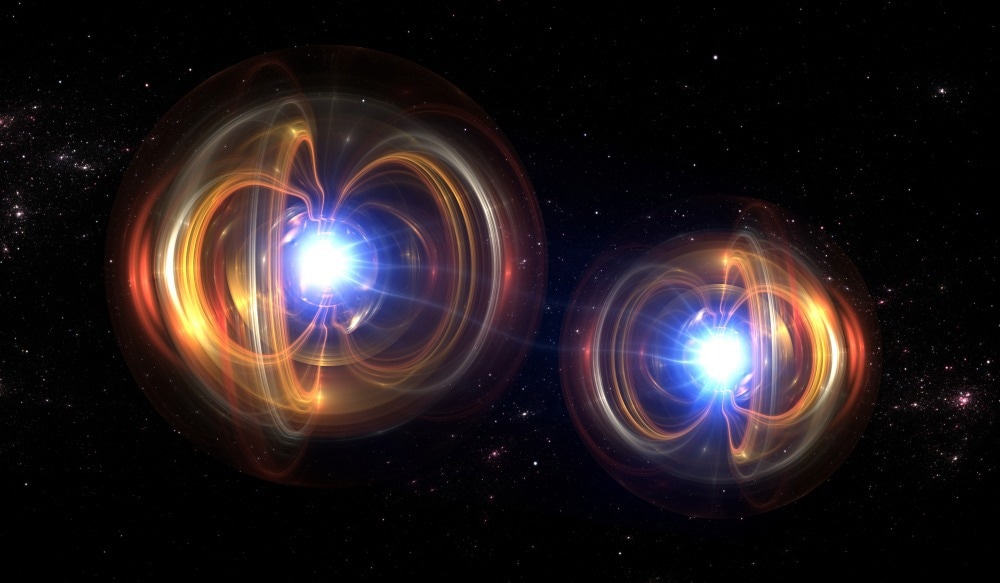Spintronics is an emerging technology that exploits the intrinsic quantum properties of particles like the electron, and the associated particle angular moment, called spin, in addition to the particle's electric charge.

Image Credit: Jurik Peter/Shutterstock.com
The dynamic control of the electron spin offers possibilities for creating novel quantum-mechanical devices, such as spin transistors, spin valves, and high-density memory. Spintronic systems are of particular interest in the field of quantum sensing, computing, and data processing.
What Is Spintronics?
Conventional electronic devices rely on the generation, transport, manipulation, and detection of electric charge carriers, such as electrons and holes.
Spintronics employs the intrinsic angular momentum of the particles (spin) together with their electric charge. The electrons exist either in spin-up or spin-down states, which can represent 0s and 1s in logic operations.
However, to build spintronic devices, the properties of the materials are crucial. In most materials, the spin-up and spin-down magnetic moments cancel each other, making them unsuitable for spintronic applications. In ferromagnetic materials, particles with the same spin state can accumulate in a majority-up and majority-down domains.
The spin state in these randomly scattered domains can be easily manipulated by the application of external magnetic fields. In addition, the transfer of electron spin-states between different materials and their reliable detection is also of great importance for spintronics.
Spintronics: The Technology Revolution You’ve Probably Never Heard Of
Video Credit: Seeker/YouTube.com
Spintronic-Based Quantum Devices
Most of the existing spin-based devices, such as giant magnetoresistance-based memory and spin valves, are passive spintronic elements. In such spintronic devices, the material's resistance or tunneling current in the system depends on the spin direction controlled by local magnetic fields.
The goal of the engineers and physicists developing spintronics is to move the field beyond the passive spin devices and create applications based on dynamic spin control. The two physical principles underlying the current interest in spintronics are the quantum-mechanical nature of the spin and the extended coherence time of the spin states. In particular, the coherence, or the stability of the quantum states with time, is an essential factor for spintronic and quantum applications.
By actively manipulating the spin of the charge carrier particles with spin-dependent properties, researchers envisage that they can create spin transistors, spin filters, and new memory devices suitable for quantum information processing and computation.
In these devices, the spin polarization can be controlled via spin-orbit coupling (the interaction between the particle spin and its orbital momentum), and spin waves, or magnons, can carry spin current through the material without energy loss.
The Role of 2D Materials in Spintronics
Two‑dimensional (2D) materials have been drawing tremendous attention in spintronics because of their distinctive spin‑dependent properties, such as long spin relaxation times, diffusion lengths and strong spin-orbit coupling.
Furthermore, the rapid advance in nanotechnology has enabled scientists to combine several preferred properties in one superior material through van der Waals stacking of two or more 2D material layers.
Graphene, with its high charge carrier mobility, extended spin lifetime, and long diffusion length, emerged as an excellent platform for fundamental spintronic research and eventual spintronics devices.
Recently, several research groups demonstrated spin injection in graphene at room temperature using a cobalt electrode. Spin detection has also been achieved by comparing spin-up and spin-down local currents. However, because of its zero bandgap and weak spin-orbit coupling, the material has limitations in building advanced spintronic devices, such as logic gates.
In contrast, 2D transition metal dichalcogenides, transition metal carbides, nitrides, carbonitrides, and organometallic sheets exhibit tunable bandgap and strong spin-orbit coupling, enabling reliable spin logic and non-volatile data storage.
The development of magnetic 2D materials with high Curie temperature is of particular interest, such as organometallic layered structures with embedded transition metal atoms. Such materials have been used to fabricate magnetic tunnel junction devices (ferromagnetic layers separated by a nonmagnetic layer), where the current can be controlled by the relative magnetization of the outer layers. Combining spin valves and magnetic tunnel junctions with the spin-transfer-torque writing write mechanism enabled researchers to create non-volatile high-speed magnetic random access memory.
There are several outstanding challenges related to the stability of the 2D materials and their manufacturing. Due to their atomic thickness, 2D spintronic devices are highly susceptible to moisture, oxidation, and thermal damage, thus requiring operation in a protected environment. Besides, the Curie temperature of most of the 2D magnetic materials is far below room temperature.
Most 2D materials are fabricated through mechanical exfoliation and stacking, which is time-consuming and expensive. Developing 2D materials suitable for wafer-scale synthesis and operation at ambient conditions are prerequisites for their wider adoption in spintronic applications.
The Future of Spintronics and Quantum Computing
Spintronics is at the point of becoming a mainstream technology similar to semiconductor-based microelectronics. Ongoing research and development efforts aim to integrate spintronics and photonics into a common platform for light-based and spin-based quantum computing. By using specially designed photonic circuits, researchers are hoping to be able to control the electron spin dynamics in nanostructured 2D magnetic materials when excited by short laser pulses.
References and Further Reading
Ahn, E.C. (2020) 2D materials for spintronic devices. npj 2D Materials and Applications, 4, p. 17. Available at: https://doi.org/10.1038/s41699-020-0152-0
Hu, G & Xiang, B. (2020) Recent Advances in Two-Dimensional Spintronics. Nanoscale Res Letters, 15, p. 226. Available at: https://doi.org/10.1186/s11671-020-03458-y
Feng, Y.P., et al. (2017) Prospects of spintronics based on 2D materials. WIREs Comput Mol Sciences, 7, p. e1313. Available at: https://doi.org/10.1002/wcms.1313
Awschalom, D. D., et al. (2013) Quantum spintronics: engineering and manipulating atom-like spins in semiconductors. Science, 8, p. 339, 6124-1174-9. Available at: https://doi.org/10.1126/science.1231364
Disclaimer: The views expressed here are those of the author expressed in their private capacity and do not necessarily represent the views of AZoM.com Limited T/A AZoNetwork the owner and operator of this website. This disclaimer forms part of the Terms and conditions of use of this website.